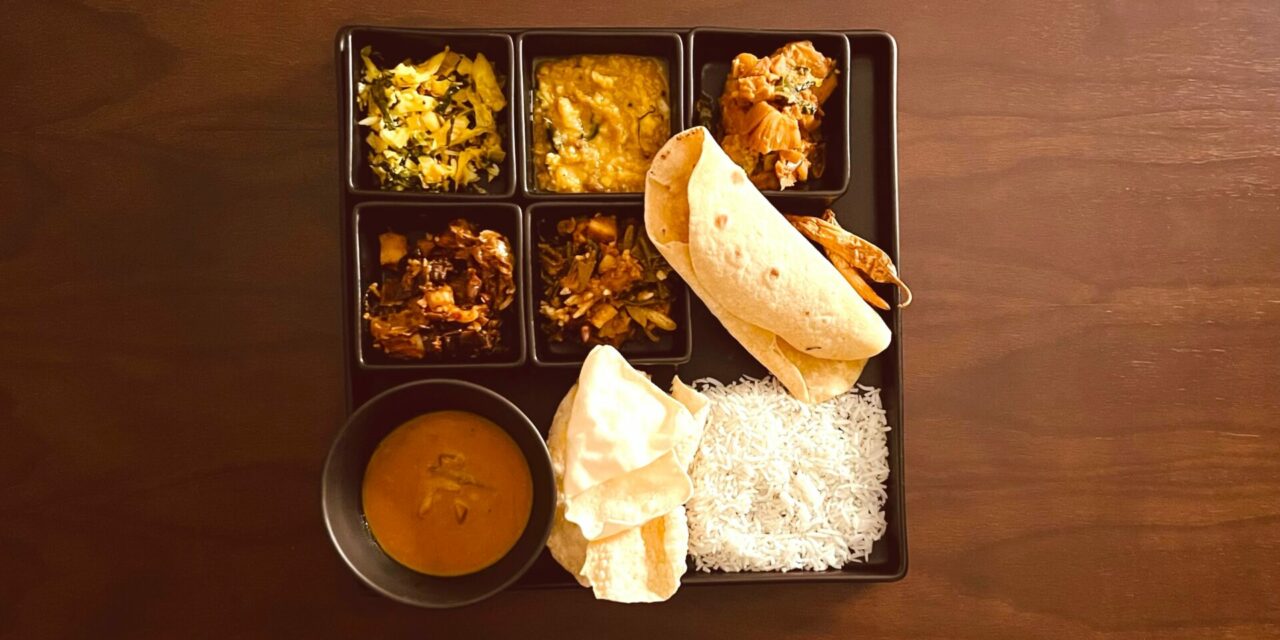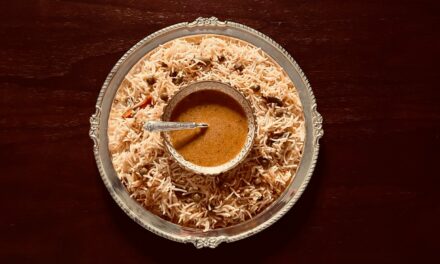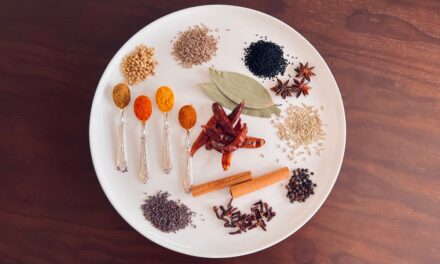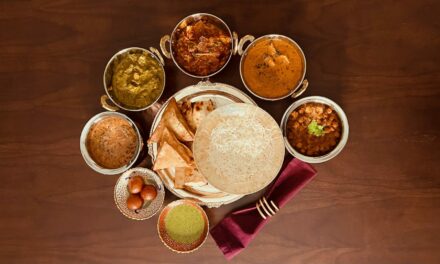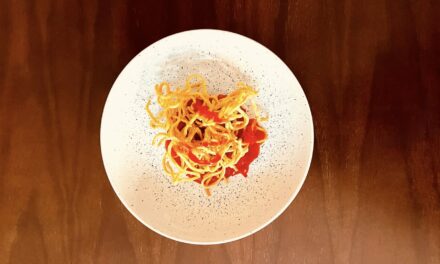In this instalment of my series on pairing South Asian food with wine, I focus on pairing wine with two iconic categories of South Indian food, thalis and tiffin!
If you enjoy South Asian food, you have probably tried a thali before. As opposed to meals that are plated and served over multiple courses, a thali is an entire meal served all at once, on one plate. A South Indian thali is made up of several different foods. It usually includes sambar (spice and tamarind-infused lentils cooked with vegetables) and rasam/charu (a peppery preparation of soup-like consistency, made with pepper and tamarind, lemon, and/or tomatoes). Other foods that are often included in a thali are lentils cooked with vegetables, sautéed vegetables, fried pappadams, rice, and dessert. The advantage of a thali is that one can mix and match its different components in whatever order one likes. I often punctuate my meal with little bites of dessert, rather than saving it for last!
Tiffin, on the other hand, is an informal snack or light meal eaten in the morning or late afternoon. Examples of foods eaten for tiffin include idli, dosa, and/or vadas, served with sambar and an assortment of chutneys. The etymology of the word “tiffin” is Anglo-Indian, probably rooted in the word “tiffing”, archaic British English slang for taking a small drink or sipping a drink. During the British Raj, British officers began using the term to refer to the Indian custom of having a light meal in the afternoon, a practice they adopted, in lieu of a heavy luncheon, to adapt to the heat. Udupi restaurants (you can read more about Udupi restaurants here), which have become ubiquitous in India and can be found in North American cities too, typically serve tiffin. Over time the term has evolved. “Tiffin” now also refers to homemade lunches that people carry to work, or schoolchildren take to school.
While both thalis and tiffin are common across South India, there are subtle regional variations in how these foods are prepared. For instance, how people cook sambar can differ across the region. In Tamil Nadu, it is made with a dry mix of roasted and ground spices, while in Karnataka, a wet spice paste is used. In some regions, it is common to add ground coconut to sambar, in others it is not. Even the types of vegetables added to sambar vary by region and/or community. Nevertheless, thinking broadly about wine pairings for South Indian tiffin and thalis can be helpful, given general similarities in the cuisine, although adjustments for regional variations may be necessary.
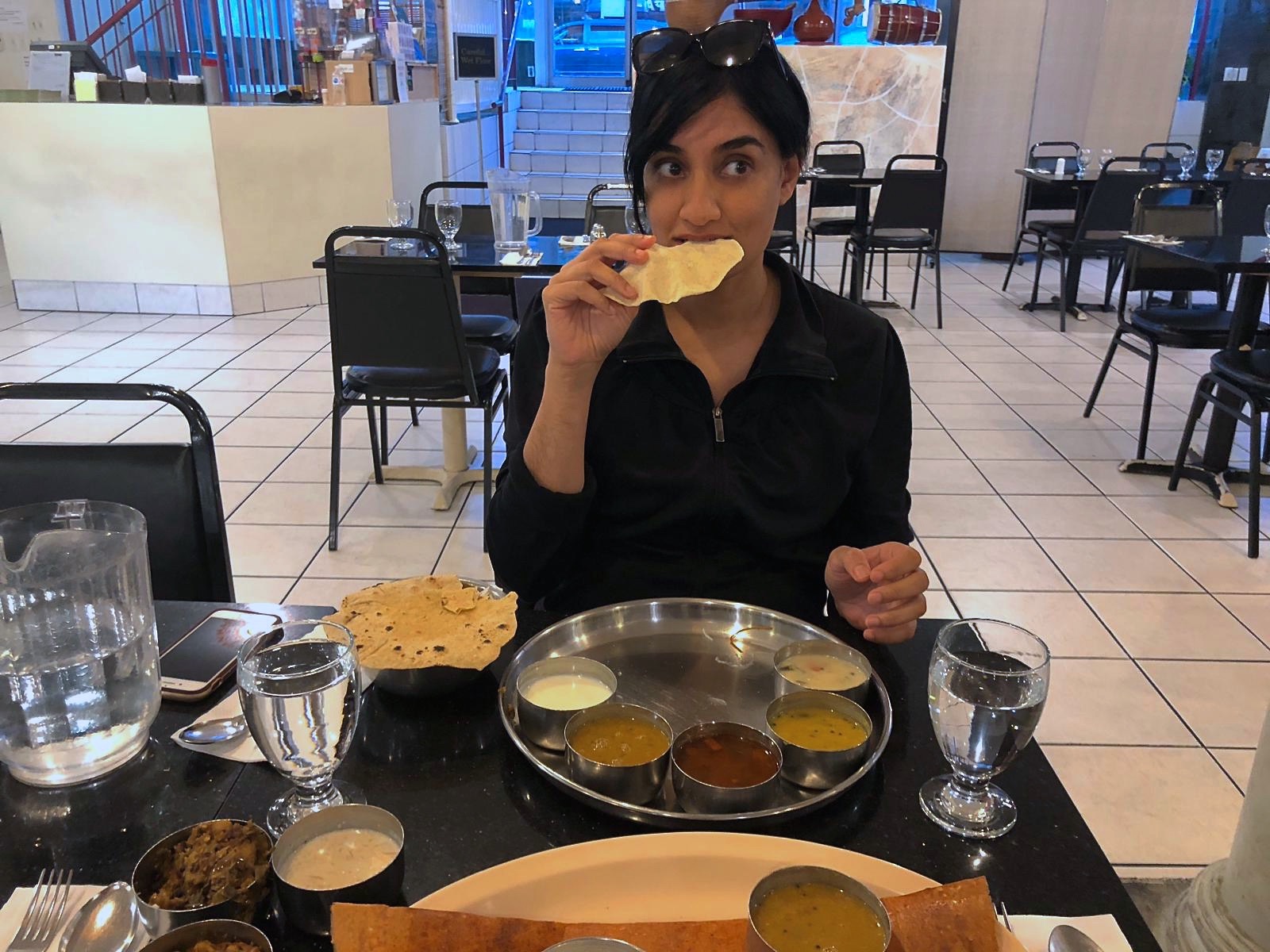
Getting Creative: Tasting Flights
For those of us who want to pair our food with wine, a thali necessitates some creativity. When a meal is served in stages, it is relatively easy to pair a different wine with each phase of the meal. How does one pair wine with a thali that is made up of so many components served all at once? There are two approaches that I have found work best. The first, and easiest option, is finding a wine that works with all the different components of a thali. Given the diversity of flavours and textures in an average thali, this is not easy and might mean picking a wine that is not an optimal pairing for any of the components of the meal. The second approach is to serve multiple wines, a tasting flight of sorts, with a thali. I think the latter idea works particularly well at an informal dinner party. The host can offer guests two or three wines to experiment with; alternatively, each guest could bring a different wine to try with the meal.
Since both approaches have their appeal, I am going to divide my recommendations for wine into two categories, each corresponding to one of these approaches. First, I will highlight pairings that stand out to me, where the wine and food tend to elevate each other. Next, I will identify wines that are likely to pair with most components of a thali but may not be the most favourable pairing for any of them.
Things to Keep in Mind
Before we dive into specific wine pairings, here are a few broad principles or guidelines, if you will, that I found helpful when trying to pair wine with tiffin and thalis:
- To Mirror or Contrast? Of the two broad approaches to pairing food and wine, focussing on contrasting flavours is more likely to produce a successful match with most South Indian food. The flavours in the food are usually so powerful that they do not need further amplification.
- Structure: When pairing wine with South Indian food, the wine’s structure is the single most important factor. Wines with bright acidity refresh the palate and complement the tanginess of food made with souring agents like tamarind or tomato. A hint of sweetness in the wine balances heat from spices. In contrast, higher alcohol wines accentuate the heat from chillies, a positive development for some people and a negative one for others.
- Intensity: The intensity of the wine is another key factor to consider; bolder wines with concentrated flavours stand up to spices and other strong flavours in the food.
- Fruit Versus Non-Fruit Flavours: As a rule, fruit-focussed wines pair well with spice-infused foods. Both juicy, ripe fruit profiles and tangy, tart ones have the potential to work with South Indian food. What is key is that fruit flavours take centre stage on the palate.
- To Oak or Not to Oak: The extent to which oak plays a role in the flavour profile of the wine is also relevant. Distinctive, bitter oak flavours (like smoke, cocoa, and coffee) clash with the flavour profiles of most South Indian foods.
- Service Temperature: This may be obvious to some, but an important and simple way to enhance the interaction between spicy food and wine is to chill the wine. In my experience, in addition to cooling white, sparkling, and rosé wines, red wines should also be served lightly chilled or at cellar temperature to complement the heat and richness of the food.
- How the Food is Served: South Indian food is sometimes served on a banana leaf. Serving hot food on a fresh banana leaf can impart cooked herbaceous and leafy aromas and flavours to the food. If you are eating food off a banana leaf, or if it comes packaged in a leaf (some restaurants wrap takeout in banana leaves even in North America), this can influence the relationship between the food and wine.
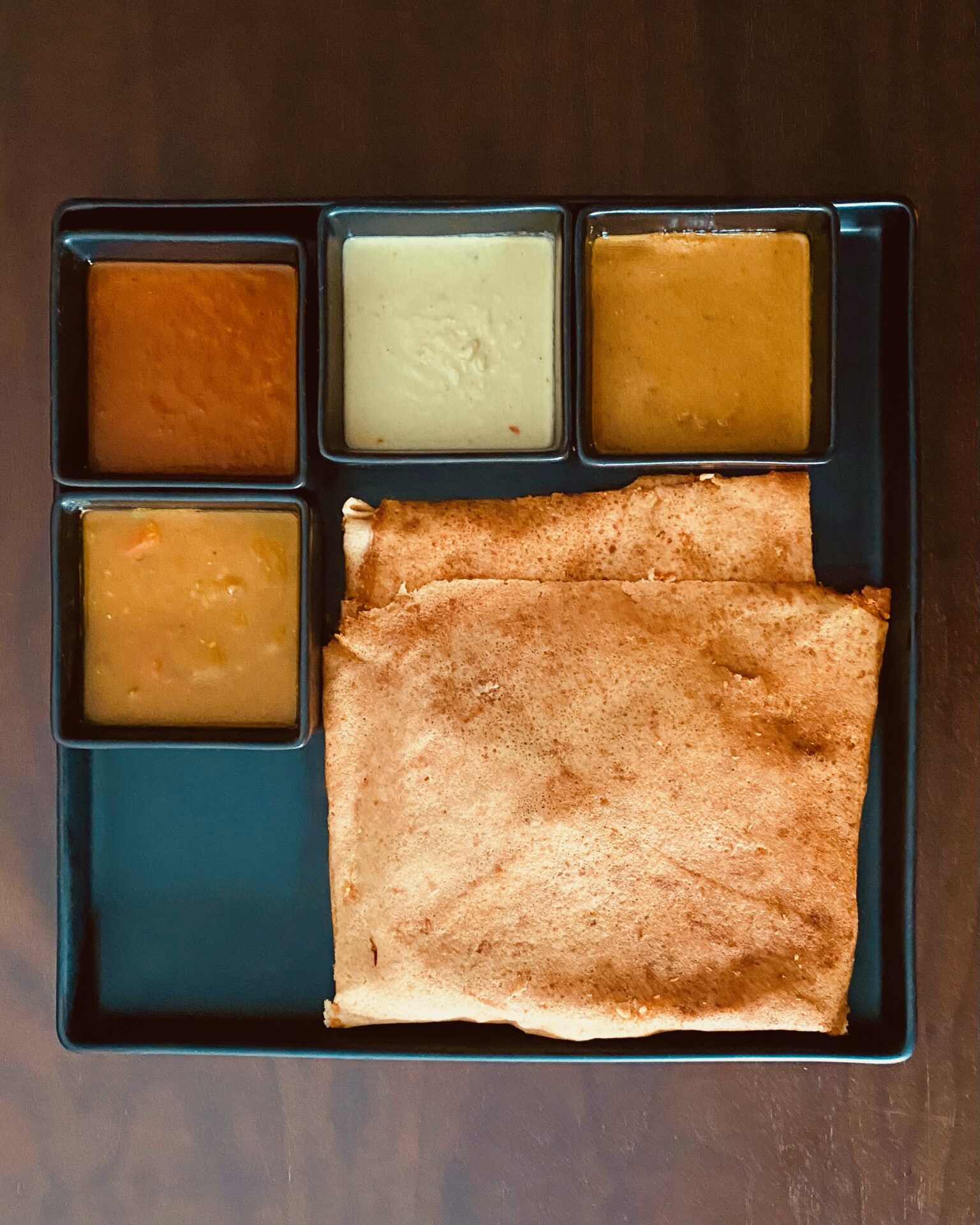
With these general principles in mind, let us explore wine pairings for some quintessential examples of South Indian cuisine.
Pairing wine with a Thali
Stand out pairings: Gamay Noir, Pinot Noir, Albariño, and Sauvignon Blanc.
Ripe, fruity expressions of Gamay, with mild to moderate tannins, and vibrant acidity pair nicely with many components of a thali. Gamay seems to work particularly well with slightly herbaceous or vegetal dishes like sautéed beans, ivy gourd, and aubergines. Fruit-forward Ontario Gamays, such as Hidden Bench’s Unfiltered Gamay, are good candidates in this context. On the other hand, Gamay can taste a bit thin and bitter with some parts of a thali such as dals that do not include a souring agent (like tamarind or tomatoes) and bitter foods like sautéed cabbage. Similarly, fruit-focussed Pinot Noir with little to no new oak-treatment can work with some components of a thali. In contrast, delicately flavoured, less fruit-forward, and austere Gamays and Pinot Noirs are likely to appear muted and thin when served with a thali.
A ripe, fleshy Albariño tastes deliciously tart, fruity, and saline with many components of a thali, but it can appear a bit thin and bitter when juxtaposed with bitter lentils that lack tartness. Instead, a fruity, vibrant Sauvignon Blanc is a better match for lentil-based foods. It is also a good accompaniment for sautéed vegetables like aubergines and French beans. The vegetables and spices highlight the rich tropical and citrus fruit flavours of a ripe sauvignon blanc, while the wine’s ripe, subtly sweet fruit flavours provide a welcome contrast to the spicy, salty, and savoury notes in the food. Meanwhile, the herbaceous components of both the food and wine mirror each other. Tart tomato-based sauces also pair well with sauvignon blanc because of its bright acidity.
All-rounders: Sauvignon Blanc and sparkling rosé.
To use cricket parlance, a ripe Sauvignon Blanc with vivid fruit flavours and around 5g/L of residual sugar is a good “all-rounder” wine pairing for a thali. Sparkling rosé is also a good choice. It works reasonably well with most components of a typical thali. Its bright acidity and effervescence refreshes the palate between bites and the bubbles and faint tannins contribute to a sensation of volume on the palate, keeping the wine from feeling too lean or thin. I recommend something with concentrated fruit flavours, bright acidity, and subtle sweetness (less than 10g/L residual sugar).
Wine and Tiffin
Stand-out pairings: Gamay Noir, Pinot Noir, and Albariño.
Dosas, idlis, and vadas are served with sambar and a collection of chutneys, the most common being coconut, spicy peanut, and tart tomato-based chutneys. To complicate matters, there are several types of dosas, although here I focus on pairings for plain, masala, and cheese dosas. While cheese dosas are a relatively recent addition to tiffin, they have been gaining popularity in India and often appear on menus in South Indian restaurants all over India and North America.
My favourite tiffin pairings are Gamay and Pinot Noir with cheese dosa. Gamay in particular highlights the savoury characteristics of the dosa, while the acidity and fruity flavours in the wine provide a refreshing contrast to the richness of the cheese and ghee in the dosa. Moreover, the tart fruit flavours in the wine really shine in juxtaposition with the salty, rich flavours of the food. Albariño also works well with cheese dosa; I like how the wine retains its rounded texture and generous fruit flavours.
All-rounders: Albariño and Sauvignon Blanc.
Ripe, fruity Albariño with a rounded, medium-bodied palate pairs well with dosas, idlis, and vadas. That said, all these foods, except for cheese dosa, make the wine seem somewhat leaner while intensifying its grapefruit or citrus zest-inflected finish. Although this might not appeal to some, I think this makes the wine appear to have more verve and energy, while the zesty, citrusy flavours are refreshing and a pleasing contrast to the savoury, salty flavours of the food. Ripe Sauvignon Blanc with around 5g/L of residual sugar also pairs well with these foods. Like Albariño it appears somewhat leaner though, and tropical fruit notes in the wine take a backseat while citrus flavours like grapefruit and lime lead.
Bittersweet Endings
Sauternes is a delicious accompaniment to one of my favourite South Indian desserts, kesari. The dessert is made with semolina, sugar, ghee, water, milk, saffron, dried fruit, and nuts. The acidity and subtly bitter finish of Sauternes is a refreshing counterpoint to the sweetness of the kesari and saffron notes in the kesari amplify those in the wine.
Payasam is a pudding made with rice, dried fruit, nuts, and spice. Served warm and paired with a small glass of Pedro Ximénez it is a delightful after-dinner treat as the weather becomes cooler. This rich, honeyed Sherry contrasts nicely with the gelatinous texture of the payasam and highlights notes of dried fruits and nuts in it. Conversely, the payasam provides a wonderful backdrop for the delicious caramel and coffee infused finish of the wine.
A Final Note
As with all food, South Indian food is not the same everywhere. Apart from regional variations, differences arise when individuals adapt recipes and traditional preparations. Some people make their sambar more bitter; others make it tarter or sweeter. Add to this the complexity of numerous textures, ingredients, and flavour profiles, and trying to find wine pairings for South Indian food inevitably involves some trial and error. As you experiment with different recipes and pairings, especially if you try out my “thali and tasting flight” suggestion, you should begin to develop a sense of what works best for you!
In the next instalment, I will explore pairing wine with Hyderbadi cuisine. Until then, happy experimenting.

